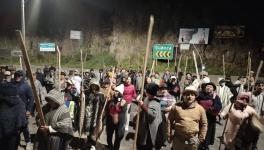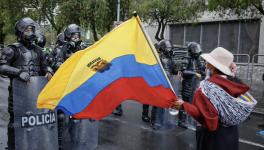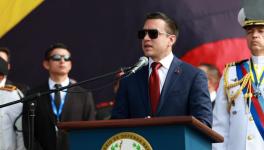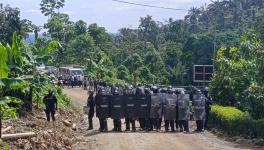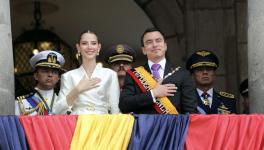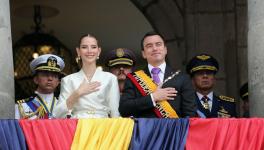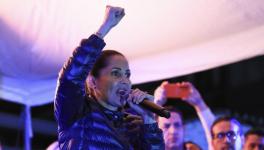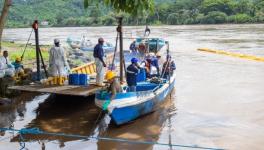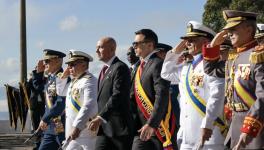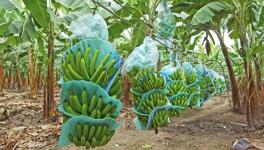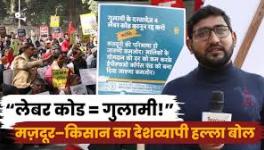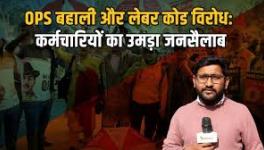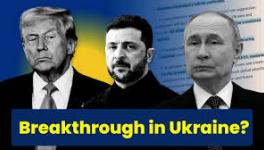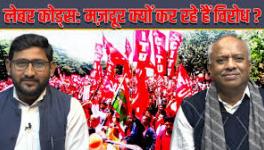Ecuador: National Strike Faces Heavy Repression
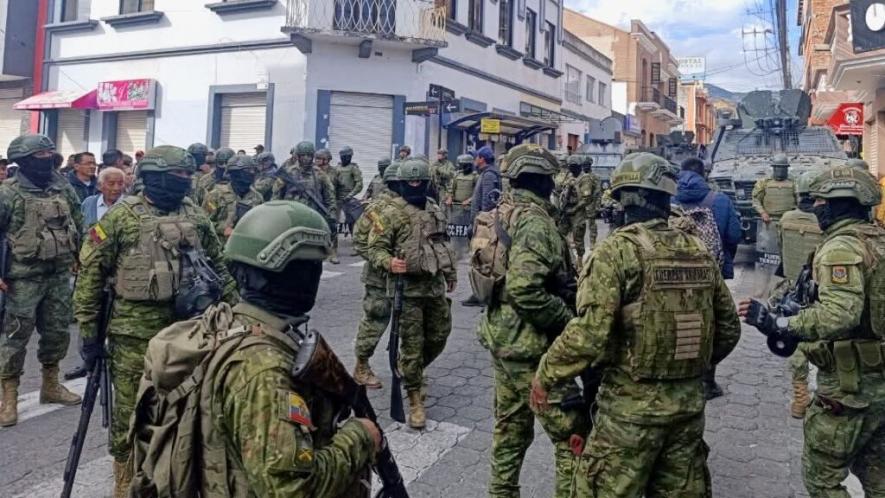
The National Police and the Army have not hesitated to use force to clear the roads and disperse the protesters. Photo: CONAIE
Following the announcement by Ecuador’s right-wing President Daniel Noboa to eliminate the diesel subsidy, several protests have taken place across the country demanding the repeal of the decree. In Ecuador, diesel is used for transportation and agriculture. Before the decree, the cost per gallon was set at USD 1.80; now it costs USD 2.80.
This increase has a direct impact on food production and marketing prices, which is already evident in the markets, as well as on the cost of passenger transport, which could prove very problematic for a country undergoing a prolonged economic and security crisis.
The measure was initially rejected by the transport union, although they quickly reached an agreement with government negotiators. However, the Confederation of Indigenous Nationalities of Ecuador (CONAIE), the country’s most significant social movement, declared that it would initiate indefinite mobilizations starting on September 22.
In 2019 and 2022, CONAIE led massive protests against the governments of Lenin Moreno (2017-2021) and Guillermo Lasso (2021-2023), who attempted to eliminate fuel subsidies. The protests, in which dozens of people died, halted the economic measures requested by the International Monetary Fund. However, it seems to be a non-negotiable point that successive right-wing governments insist on implementing, with the Noboa government (2023-present) being the one that has most significantly advanced the neoliberal economic program.
Mobilizations
“Sisters and brothers, today we begin the National Strike. We are not criminals or terrorists; we are a dignified people who demand respect for life, rights, and territories. The government’s response cannot be repression or persecution, but rather listening to the legitimate demands of the people. We call for unity among all sectors to raise, with firmness and dignity, our collective voice for the future of our families and our country,” said Marlon Santi, president of CONAIE.
On September 22, some of the country’s major roads were closed by protesters, especially in the provinces of Carchi and Pichincha. In Cotopaxi, Chimborazo, and several provinces in the Amazon, road closures and some clashes with law enforcement officers seeking to clear the blocked roads have been reported.
At the start of the demonstrations, the cities of Latacunga and Otavalo woke up militarized, as the government decided to temporarily move the presidency and vice presidency there, respectively, in hopes of containing two of the most active sites of Indigenous mobilization.
However, the province of Imbabura, where Otavalo is located, has become one of the most active sites of protest as the days have passed. Thousands of protesters have clashed with the police, who have decided to crack down and imprison several protesters.
The harsh actions of the security forces
Several human rights organizations, such as the Regional Foundation for Human Rights Advisory Services (INREDH), have reported that protesters claim that abuses and harassment have been committed by the security forces. These allegations were echoed by the Waorani Nationality of Ecuador (NAWE), which represents an Indigenous Amazonian population: “[We were] repressed by the public forces.”
This seems to be the tone of the protests across the country. The National Police and the Army have not hesitated to use force to clear the roads and disperse the protesters. According to the minister of government, Zaira Rovira, so far, after three days of protests, 59 people have been arrested.
For his part, Security Minister John Reimberg claimed that the strategy of the Indigenous leaders is for one of the protesters to be killed: “What these pseudo-Indigenous leaders are looking for is to victimize themselves and for us to use force in such a way that an Indigenous person is injured or killed.” He also pointed out that among the protesters are members of the Tren de Aragua, a Venezuelan criminal organization, which would demonstrate an alleged hidden agenda.
These claims have been strongly denied by Indigenous leaders, who assert that such statements are a ploy to delegitimize the struggle of the Ecuadorian people and legitimize increasingly radical repression against protesters. “We are not terrorists! We are peasants, farmers, workers, students, we are a people demanding our rights,” wrote Leonidas Iza, former president of CONAIE and leader of the protests in 2019 and 2022.
Repression was also evident in the country’s capital, Quito, where on September 23, several students and workers took to the streets to protest the Noboa government. Students and professors from the Central University of Ecuador closed Avenida América in rejection of the elimination of subsidies; they later joined a workers’ march that advanced through various parts of the city.
Another group of people demonstrated at night in the north of the capital, where they reported beatings and abuse by the police. In a video that went viral, a police officer is seen spraying pepper spray into the mouth of a protester who was shouting his name as he was being taken away by the police. The same happened with a video showing law enforcement officers firing at the occupants of a van fleeing repression in Saquisilí, Cotopaxi province.
The context of the protests
The demonstrations are in addition to several protests by students, workers, and teachers that have taken place in recent months in the country against the neoliberal policies of the Noboa administration.
However, the executive branch has not slowed down its plan but rather accelerated it. On September 23, the president explained this very clearly: “We will not back down, as we did in 2019, as we did in 2022. We must show firmness and compassion to those who truly need it. Before they try to make me back down, I would rather die. I am staying here and I will be fighting every day for each and every one of you,” he said at a rally before his supporters.
But the truth is that Noboa, who is following the agreements signed with the IMF to the letter, has a more ambitious plan than simply eliminating the diesel subsidy. In recent weeks, Noboa identified his new enemy as the Constitutional Court (CC), which rejected several articles of the recent laws passed by a Congress controlled by the ruling party.
This strategy sought to preempt one of the changes most desired by Ecuador’s economic elites (to which the president belongs, as the son of the richest man in the country): to eliminate the 2008 constitution, which undoubtedly has anti-neoliberal roots, as it prohibits the privatization of public services and defends the rights of workers and nature, among other provisions labeled by constitutional lawyers as “guarantees”.
Noboa’s plan seems to have worked. After two demonstrations and a media campaign against the judges, the CC agreed to a referendum asking Ecuadorians:
- If they want to call a constituent assembly
- If they approve of foreign military bases
- If they want to end state funding for political parties
These are the three main pillars of the plan to restructure Ecuadorian politics and the economy.
In this sense, the current protests are not limited to the elimination of the diesel subsidy – a fundamental step in the government’s economic program – but also express a series of social, economic, political, and security issues (Ecuador is now the most violent country in Latin America) for which the protesters blame the Noboa administration. Many see the protests as one of the last chances to curb the neoliberal intentions of the executive branch, which does not seem to have any intention of slowing down.
Meanwhile, the government is betting on the proposed referendum to carry out its governing plan. A plan which, despite electoral promises, does not seem to be curbing unemployment, murders, and the widespread social crisis affecting the country. In the coming days, we will see whether the protests manage to gain momentum, as they did in 2019 and 2022, consequently undermining the popularity of the presidency, or whether, on the contrary, the government manages to get its way, eliminate the subsidy, and emerge stronger to face a possible referendum vote. This is undoubtedly its toughest obstacle so far.
Courtesy: Peoples Dispatch
Get the latest reports & analysis with people's perspective on Protests, movements & deep analytical videos, discussions of the current affairs in your Telegram app. Subscribe to NewsClick's Telegram channel & get Real-Time updates on stories, as they get published on our website.









